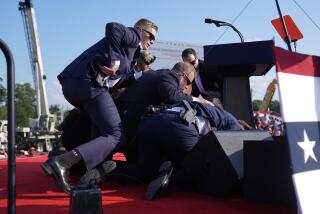A Guardian of the White House Treasures : Art: LACMA’s Leslie Greene Bowman finds satisfaction as a presidential appointee to a committee dedicated to preserving America’s most visited home.
- Share via
The White House must be the most frequently redecorated domicile in the country. From Thomas Jefferson’s Federal-style furnishings and James Monroe’s gilded Empire furniture to Chester A. Arthur’s elk-antler chairs and Theodore Roosevelt’s polar bear pelts, the executive mansion has evolved with the tastes and budgets of its residents.
But the ever-changing decor is also a matter of necessity.
“With 1,250,000 people visiting the public rooms of the White House each year, things wear out,” says Leslie Greene Bowman, head of the Los Angeles County Museum of Art’s decorative arts department and a presidential appointee to the Committee for the Preservation of the White House.
Indeed, as America’s most visited home--and the only residence of a head of state that is open to the public on a regular basis free of charge--the White House takes quite a beating. The days when Roosevelt used the East Room as a wrestling arena and his children turned it into a roller-skating rink are long gone, but accommodating the crowds requires enormous effort.
Beyond routine cleaning and maintenance, the mansion’s antique furnishings and 40,000-piece collection of fine and decorative arts demand professional attention, Bowman said. Appropriate replacements must be found for worn-out carpets, shabby upholstery and faded draperies. Artworks and other objects need conservation. And when gifts are offered to the White House, someone must decide if they fit into the collection.
This is the province of White House curator Rex Scouten and his staff, who work in consultation with the First Family and the committee.
The committee is composed of seven ex-officio members and 13 presidential appointees--including interior designers, curators, art historians and arts patrons--and reports to the President and advises National Park Service Director Roger G. Kennedy on the maintenance of the White House as a public monument. The full committee convenes twice a year, while subcommittees for fine art, decorative arts and design meet as needed to address problems in their area of expertise.
“We are working on the Blue Room now,” Bowman said. “It’s such a great room, but it is sorely in need of a face lift,” she said of the oval-shaped reception hall that she considers “the most dramatic and elegant of the public rooms.” The task at hand is to help select new draperies, upholstery, wall coverings and carpet.
Bowman, a member of the decorative arts subcommittee, has located an 1815 English carpet design that might be re-created for the Blue Room, while some of her colleagues have scoured New York’s Cooper-Hewitt Museum for period wallpaper. Committee members are appointed because they know where to look for answers about White House furnishings, but they are merely advisers, not final arbiters, Bowman emphasized.
Still, she has emerged from initial meetings with a rush of excitement. “I just think it’s an incredible honor,” Bowman said of her appointment, which took effect in November but was only made public in March. “I didn’t ever think, even in my wildest dreams, that I would play any role remotely involved with advising the President on the White House.
“One reason this means a lot to me is that I came to Los Angeles in 1980, directly from graduate school at Winterthur (Museum and Gardens in Winterthur, Del.), when the County Museum of Art was not known for its decorative arts and certainly not for its American decorative arts,” she said. “People asked me why I was going to Los Angeles. During my 13 1/2 years here I’ve had the feeling that my work doesn’t get as much notice as it would if I were in New York or Boston, but now I know I haven’t been forgotten.”
The Committee for the Preservation of the White House was established by Lyndon B. Johnson in 1964 as an outgrowth of Jacqueline Kennedy’s work on the White House, according to Scouten, who has held his post for eight years.
“Originally the members were selected for their ability to give or raise funds to refurbish the White House. But now the collection is almost adequate, so we have a more professional committee,” he said. Fund-raising is done by the White House Historical Society, while committee members concentrate on the mansion and its collection.
John and Abigail Adams, the first residents of the White House, moved into the executive mansion in 1800, while it was under construction. But the bulk of the collection is only 30 years old, Scouten said. The house underwent an extensive renovation during the Truman Administration but--apparently due to a lack of funds--it was furnished with reproductions.
A privately funded effort has replaced all the reproductions with authentic antiques, Scouten said. They include pieces that had been sold off over the years, such as gilded furniture from Paris’ Belange workshop ordered by Monroe in 1817 for the Blue Room. But the holding isn’t as big as it sounds, Scouten said. The 40,000 pieces include flatware, porcelain and dozens of other relatively small objects--few of which are relegated to storage.
While Scouten has long since settled into his unusual job, Bowen confesses to being awe-struck by her new responsibility. “Both President and Mrs. Clinton speak very passionately and evocatively about the power of history that is conveyed by the house,” she said. “Mrs. Clinton is actively involved in every committee meeting, which is very gratifying.”
But perhaps the biggest thrill, Bowman said, is entering the house itself: “I’m completely in awe of the fact that when you go to the White House, you go to the front door. You go to the guard’s kiosk, get clearance and walk up to the front door. I find that completely overwhelming and awesome.”


